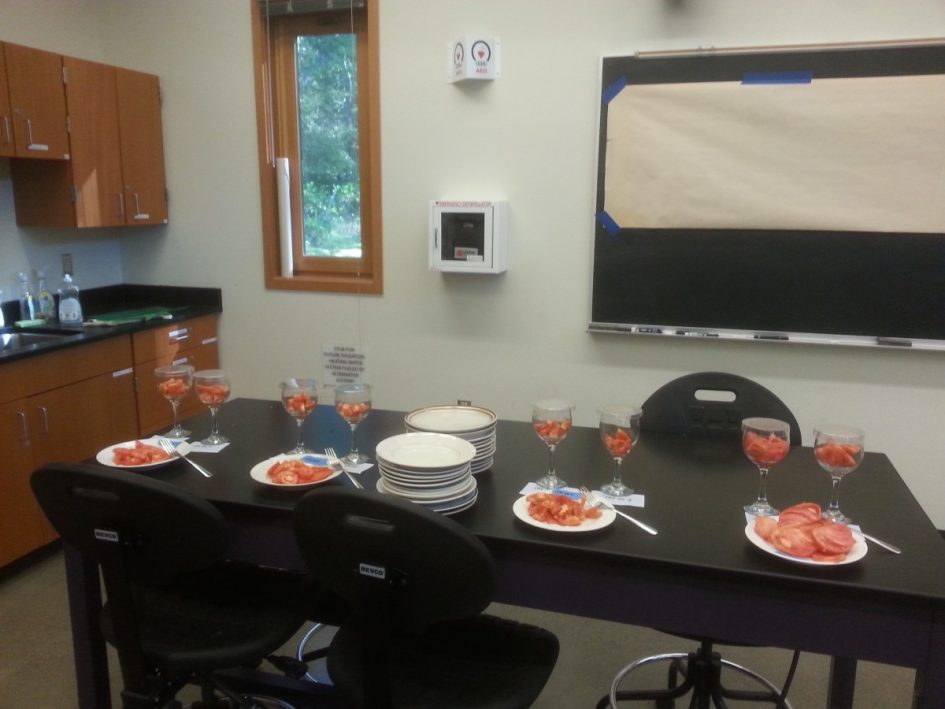It turns out that evaluating taste and flavor is exceedingly complex. There are multitude of things that effect how we perceive sensations. For example, background noise enhances umami perception, but diminishes sweet perception. This is one reason behind the popularity of tomato juice on airplanes. It’s packed with umami-receptor ligands like glutamic acid. Flavor of course is a multimodal sensation comprised of tastants (acids, sugars, bitter compounds, etc), volatile aroma molecules as well as the mouthfeel. But our experiences, memories and culture affect how we feel about these complex sensory interactions, since a small portion of the nerve signal is directed to our limbic system. These are just some of the factors involving how humans perceive flavor. There is a whole other set of variables that challenge scientific study of flavor and flavor perception when considering the tomatoes: genotype, soil nutrients, soil composition, neighboring plants, microecology of the soil and rhizosphere, sunlight, temperature, maturity when picked, etc.
Over the summer I was lucky enough to find myself in an e-mail exchange with Dr. Ann Noble, a retired professor from UC-Davis and creator of the wine aroma wheel. At one point, the NY Times did an article on Ann when she was embarking on creating another aroma wheel for tomatoes. It never happened, but she was kind enough to send me a list of aroma descriptors she had developed from her tastings. By the way, the development of a flavor wheel for tomatoes is currently part of another Greener’s work with Culinary Breeding Network. In fact, CBN sent us the ballots I used for some of my tastings with Evergreen programs. Ann also suggested cutting tomatoes and placing them in covered wine glasses to assist in perceiving some of the more subtle volatiles in tomatoes. This was brilliant, and worked very well.
For the NOVIC data, I used groups of friends and family throughout the trial to conduct sensory evaluations. Tasters were given 3 ripe fruit of the same variety and asked to examine them like they would at a market. I had them rate each variety for appearance, flavor, sugar-acid balance, texture, skin thickness, and overall on a hedonic scale from 1-5. After the appearance evaluation, fruit were sliced for tasters to smell and eat. I didn’t run official stats on these because my skills with non-parametric analysis need work, but below is a table with average scores and an overall ranking for each variety; I had 10 observations for each variety.
| Variety | Appearance | Flavor | Balance | Texture | Skin Thickness | Overall | Overall Rank |
|---|---|---|---|---|---|---|---|
| (A) Home Stoop | 3.7 | 3.4 | 3.5 | 3.4 | 3.6 | 3.3 | 5 |
| (B) OSU S200 | 4 | 3.6 | 3.5 | 3.8 | 3.9 | 3.7 | 4 |
| (C) Stellar | 3.8 | 3.1 | 3.4 | 2.9 | 3.4 | 3.2 | 7 |
| (D) Matina | 3.2 | 3.8 | 4.2 | 4 | 3.5 | 4 | 1 |
| (E) Estate | 4.3 | 2.3 | 3.2 | 2.3 | 2.9 | 2.6 | 8 |
| (F) Plum Perfect | 3.6 | 2 | 2.3 | 1.8 | 1.8 | 1.9 | 10 |
| (G) Damsel | 3.6 | 4.2 | 3.7 | 3.7 | 3.9 | 3.8 | 3 |
| (H) Crimson Sprinter | 3.9 | 4.2 | 4 | 4 | 3.7 | 4 | 1 |
| (I) Plum Regal | 3.3 | 2.8 | 3.6 | 3.2 | 3.6 | 3.3 | 5 |
| (J) OSU LB8-7 | 2.5 | 2.3 | 2.2 | 1.2 | 1 | 1.7 | 11 |
| (K) Mt. Merit | 4.8 | 2.8 | 3.3 | 1.8 | 2.8 | 2.4 | 9 |
Matina, Crimson Sprinter, OSU S200 and Damsel were the highest overall ranking. The plum types (except Plum Regal) received the lowest overall scores. Not too surprisingly for me, texture seemed to be a huge deciding factor. If we take into account other traits like yield and disease resistance, Damsel seems to be the standout for the trial.
I also had the opportunity to do some different style tastings with some Evergreen programs during the first week of fall quarter. I used tomatoes in jars, beakers and wine glasses, so aromas could build. People were floored at the differences from one to the other. And it’s always rewarding to see people make connections to aroma similarities for other foods; a lot of people described pumpkin aromas. I also did the tastings for the lacto-fermented salsas and the oven-roasted tomatoes as a simple pasta sauce, which OSU LB8-7 won by a landslide.
The salsas were a huge hit. Many were interested in the recipe and said they would buy it from the farm if they sold jars at the market stand. I had folks rank each salsa from 1-5. At the end, OSU S200 received the most votes for 1st place, but only by one vote. In fact the votes for 1st were pretty well-distributed. Strangely, Damsel as a fermented salsa only got 2 votes for 1st place. Out of curiosity, I assigned values to the table with tally marks I had made to track people’s votes. Damsel received no votes for 4th or 5th place, and the most votes for 2nd and 3rd. With my value system (5 points for a 1st place vote, 4 points for 2nd place, 3 for 3rd, etc), Damsel was once again the overwhelming favorite.

Leave a Reply